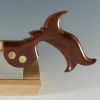Hi all. I am extremely new to woodworking so please bear with me. I have decided to make a table top and I have a few questions. I purchased some reclaimed old-growth tongue and groove heart pine. The boards are 4.25 inches thick and 7 inches wide and were used as flooring in an old (~1890s) cotton factory. Beautiful wood from what I can tell, but has some issues.
My questions are as follows:
1) Lead paint. As you can see, the boards have some white paint on them which I am fairly confident is lead paint. My current thoughts on how I would remove the paint would be to just use a planer, since I plan on planing off at least 1/4 inch off the top and bottom of the boards (maybe even more since they are so thick.) I would work outside, use a respirator, and put down plastic. Does that sound like an acceptable/safe plan?
2) Chemical coating. As you can also see in the pictures (black stuff on the boards), the boards have some sort of dark oil chemical soaked into them. The guy I bought it from thought it was cotton-seed oil, which it could be, but it smells like some sort of factory chemical and im thinking it is likely carcinogenic. (and the smell is pretty bad.) My plan for this is similar to the paint in that I am thinking the 1/4 inch planing should take care of whatever this chemical is. However, I am guessing I wont be able to get rid of all of it (it is inside the tongue and groove, which I likely wont be refinishing in any way, as that is beyond my skill level). So I was thinking a few coats of poly would protect me from whatever remaining chemicals might be inside the wood. Thoughts/advice would be welcome.
For both of the above: the oil/paint is on the inner edge of the boards as well (third picture shows this). Can I plane the inner edge of the board without screwing up the tongue-and-groove? If so, how much?
Edit: I am concerned that the chemical might be creosote. Any idea if it is? If so - am I safe in cutting away the top half inch or so? It doesnt look like it goes that deep.
Assuming the above two can be done safely, I would really like to use these boards and I'd love to hear your advice regarding finishes (below the poly that I will likely use to avoid any chemical exposure, that is).
Thank you for your help!Heart pine 5.jpgHeart Pine 1.jpgHeart Pine 2.jpgHeart Pine 3.jpgHeart Pine 4.jpg






 Reply With Quote
Reply With Quote





